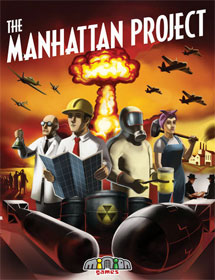



play board games
Board game reviews, strategy tips & session reports
The Manhattan Project Board Game Review
 Stats:
Stats:
No. of players: 2-5
Amount of time to play: 120 min
Age requirements: 13+
Set-up time: 5-10 minutes
The Manhattan Project Rules Description:
The Manhattan Project is a board game about making bombs. You must gather resources, build buildings and get the manpower necessary to build bombs. At the same time you can develop fighter planes and bombers to attack your opponents. And in the end victory points are all that matter.
At the start of The Manhattan Project you have a small untrained workforce and small air force. Your turn consists of placing workers or retrieving all your workers. If you don’t have any workers left to place you must retrieve your workers. When placing workers, you may place one worker on an empty space on the main board and as many workers as you like on empty buildings on your personal board.
You have three types of workers: laborers, engineers and scientists. Some action spaces and buildings require using a scientist or engineer. Others can be used by any type of worker.
On the main board there are spaces to gain money, build aircraft, mine yellow cake, train more workers, launch an air strike and build or repair buildings. These actions may be taken by any worker type. There are also spaces to design a bomb or create plutonium or uranium these can only be accessed by engineers or scientists.
Buildings act as your personal action spaces and can do most everything the spaces on the main board can do and usually more efficiently.
You can stop other players from using their buildings by bombing them with your bombers. But first you must clear out their fighter planes. You can even access their buildings by using the espionage action.
You score victory points in The Manhattan Project by building bombs. Bombs come in two flavors, Enriched Uranium and Plutonium. You need scientists and engineers and either plutonium or uranium to build bombs. The bigger the bomb (in points) the more workers and radioactive elements you need. Plutonium bombs are worth more points once you have tested one. And though this will lose you the points for blowing up the test bomb, it can gain you a lot of points on other plutonium-based bombs you’ve built.
The Manhattan Project ends once you reach a certain number of victory points based on the number of players. Reach the required number of victory points and you win!
A Quick Review of The Manhattan Project:
The Manhattan Project seems a lot more complex than it is. Build bombs and score. There are several paths to accomplishing your goal. There is a great blend of mechanics in this game and they all play well together and form a really fun final product.
You are able to affect your opponents by blowing up there buildings, or just placing your workers on their spaces using Espionage. So you have a bit of “take that” in The Manhattan Project.
You must manage your resources well and try to build bombs with the most efficiency. Some action spaces help you but also help the other players and you must be smart about when to use them.
The components are fantastic for this game (I love the little worker dudes) and the rules are easy to follow. There is a lot going on in The Manhattan Project but it is actually a fairly straight forward board game.
If you play with someone with analysis paralysis this game might irritate you. With so many choices and so much going on there is a lot for players to analyze.
I think anyone who likes worker placement games will really enjoy The Manhattan Project. And anyone given the chance should give this game a try.
Score and synopsis: (Click here for an explanation of these review categories.)
Strategy 4 out of 6
Luck 3 out of 6
Player Interaction 6 out of 6
Replay Value 4 out of 6
Complexity 4 out of 6
Fun 5 out of 6
Overall 5 out of 6

This sounds like a lot of fun; can’t wait to pick up a copy!